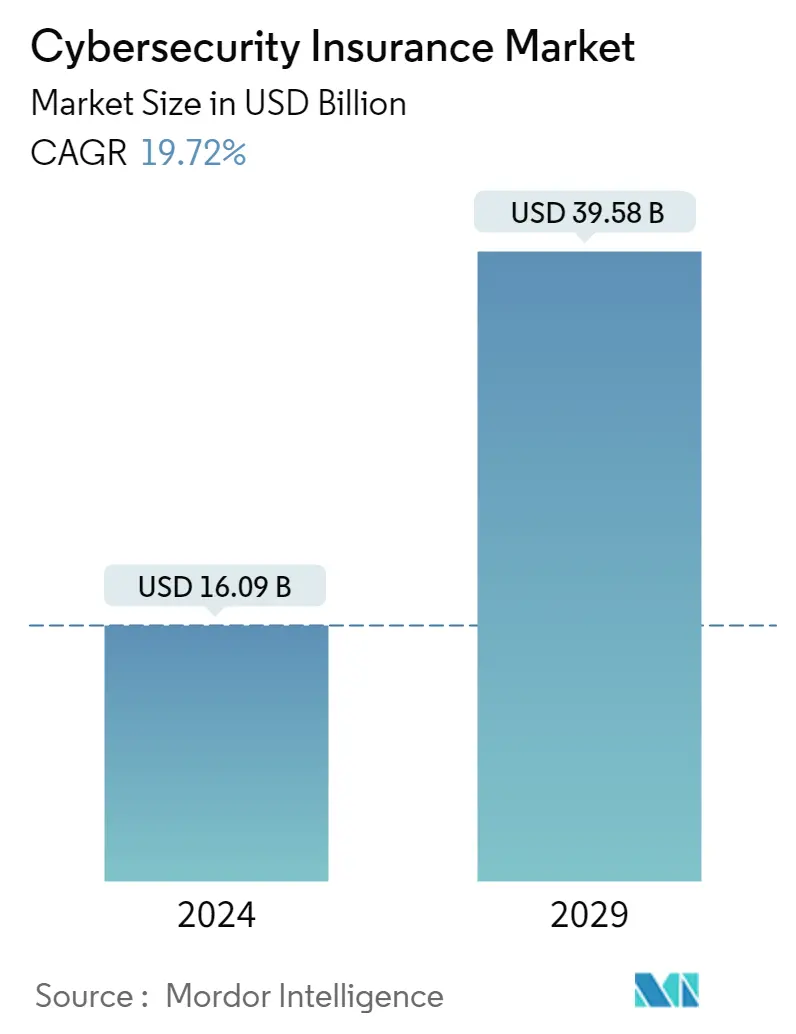Market Size of Cybersecurity Insurance Industry

| Study Period | 2019 - 2029 |
| Market Size (2024) | USD 16.09 Billion |
| Market Size (2029) | USD 39.58 Billion |
| CAGR (2024 - 2029) | 19.72 % |
| Fastest Growing Market | Asia Pacific |
| Largest Market | North America |
Major Players
*Disclaimer: Major Players sorted in no particular order |
Need a report that reflects how COVID-19 has impacted this market and its growth?
Cybersecurity Insurance Market Analysis
The Cybersecurity Insurance Market size is estimated at USD 16.09 billion in 2024, and is expected to reach USD 39.58 billion by 2029, growing at a CAGR of 19.72% during the forecast period (2024-2029).
Increasing digitalization and rapid development in the cloud, Big Data, IoT, and artificial intelligence (AI) in business and society and the growing connectivity of everything have increased the workload of already strained IT teams.
- IT advances, communication technologies, and the smart energy grid are changing the landscape of all every country's critical infrastructure and business networks. However, with rapidly evolving technology comes rapidly advancing threats. Personal data is valuable, which prompts cybercriminals to commit crimes, where personal information will be sold on the dark web, like a credit card number, identity, medical records, etc. It is among the few factors that have led to an increased demand for cybersecurity.
- Cloud computing is one of the most rapidly growing recent technologies, eliminating the traditional boundaries of IT, creating new markets, spurring the mobility trend, and enabling advances in unified communications. Various tech stakeholders and organizations are turning to new insurance models to mitigate the risks of storing sensitive data in the modern cybersecurity landscape.
- As the cybersecurity insurance space continues to mature, insurers will consider a broader range of security controls and technologies in their assessments. Hence, the sensitivity level of an organization's data and its ability to adequately obscure it will play a key role in determining the overall risk, which is driving the adoption of new technologies like micro shading. Microsharding technology breaks data into fragments that can be as small as single-digit bytes before polluting and distributing shards to multiple locations to reduce the attack surface and eliminate data sensitivity.
- Cyber insurance policies and businesses cover a wide range of risks, and insurers do not always agree on which loss events are covered. Cyber events have characteristics that make it challenging to write comprehensive policies, such as limited loss history, the unreliability of past data when predicting future events, and the possibility of a large-scale attack with highly correlated losses across companies and industries. Furthermore, insurers are still working on precise and accurate criteria for cyberattacks and the impact of new technologies like the Internet of Things. Cyber insurance coverage could be ineffective and expose firms to considerable damage if big cyberattacks occur without well-defined dangers and an understanding of how they affect insurers.
- The pandemic accelerated the adoption of digital tools, which has driven a greater need for cybersecurity insurance coverage. Various companies have been looking forward to combining insurance with cybersecurity tools to help businesses mitigate and manage cyber risk. In 2020, Coalition, a cyber insurance company, acquired BinaryEdge, a platform akin to BitSight and Security Scorecard that searches the internet and maps an organization's attack surface. The Coalition has merged terabytes of data from BinaryEdge with claims and other cybersecurity data sources to enable its risk evaluation process with machine learning and natural language processing. Further, due to the ongoing COVID-19 pandemic, countries worldwide have implemented preventive measures. With schools being closed and communities being asked to stay at home, multiple organizations found a way to enable employees to work from their homes. This resulted in a rise in the adoption of video communication platforms. In the past 6-8 months, the new domain registration on these video communication platforms, including Zoom, rapidly increased.

